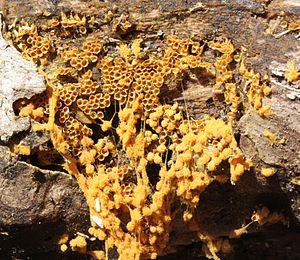Hemitrichia clavata
| Hemitrichia clavata | ||||||||||||
|---|---|---|---|---|---|---|---|---|---|---|---|---|

Hemitrichia clavata |
||||||||||||
| Systematics | ||||||||||||
|
||||||||||||
| Scientific name | ||||||||||||
| Hemitrichia clavata | ||||||||||||
| ( Pers. ) Rostaf. |
Hemitrichia clavata , sometimes referred to in German as the yellow false hair puff , is a slime mold (myxomycete) from the family of Trichiidae .
features
Hemitrichia clavata forms stalked fruiting bodies ( sporocarps ) that grow individually or in dense groups. They are club-shaped or, conversely, pear-shaped and colored golden yellow, sometimes olive-brown to olive-yellow, whereby they are tinted lighter towards the top. The surface is shiny. They reach a total height of 1 to 3 mm. The spore capsules (sporocarpies) become 0.7–1.5 mm high and 0.5–1.8 mm wide.
The membranous base ( hypothallus ) is red-brown in color and surrounds the base of the stem irregularly. In the case of fructifications in groups, it covers the substrate intermittently. The stem is dark brown at the base and lighter towards the tip. It gradually passes into the sporocarpy. In the transmitted light it appears brown. The stem becomes 0.3-1.5 mm long and about 0.2 mm thick. In the middle there are spore-like cysts that are about 10-20 µm in size.
The cover ( peridia ) opens irregularly in the upper part, with half to two thirds remaining. The edge frays partially. In transmitted light, the peridia appears light yellow. It has fine, dense warts, and sometimes an interrupted network pattern towards the stem. The hair braid ( capillitium ) is elastic and appears yellow in bulk. It is loosely present after emerging from the sporocarpy. It has grown at the base of the cup towards the tip of the stem, but otherwise free. The fibers appear light yellow to honey-colored in the transmitted light and have 3 to 5 moderately tightly wound spiral strips. These are covered with very fine spikes and thus form a lighter border. The capillitium forms a large-meshed network with a few free ends, which are sometimes thickened. The fibers are 4–7 µm thick. The spores appear yellow in bulk, light to honey yellow in transmitted light. They have a fine, fine-meshed network and fine warts; they are also clearly lined. They are spherical to broadly elliptical in shape and measure 7-10 µm in diameter.
The plasmodium is white.
Species delimitation
Hemitrichia calyculata is similar . H. clavata differs from this by a stalk that abruptly merges into the sporocarpy, droplet-shaped emerging capillitium, flatter cups and hardly lined spores. H. montana has larger spores, a shorter or missing stem. Its peridia shows a network drawing and no warts. H. intorta has more spherical sporocarpies and a prickly scalp that is turned back in on itself and a shorter stalk.
Ecology and phenology
Hemitrichia clavata usually grows on hardwood and appears even after quite dry periods. Socializations were observed with Arcyria denudata , H. calyculata , H. serpula , Metatrichia floriformis , M. vesparium , Trichia scabra and T. varia . H. clavata fructifies mainly in the months from August to May.
distribution
H. clavata is a common slime mold and is one of the most common representatives of this group in some areas. It can be found up to the higher elevations of the Alps and is widespread in the temperate zone . Finds in the tropics are, however, due to confusion with Hemitrichia calyculata .
swell
- Hermann Neubert , Wolfgang Nowotny , Karlheinz Baumann : The myxomycetes of Germany and the neighboring alpine region with special consideration of Austria . tape 1 . Karlheinz Baumann Verlag, Gomaringen 1993, ISBN 3-929822-00-8 .